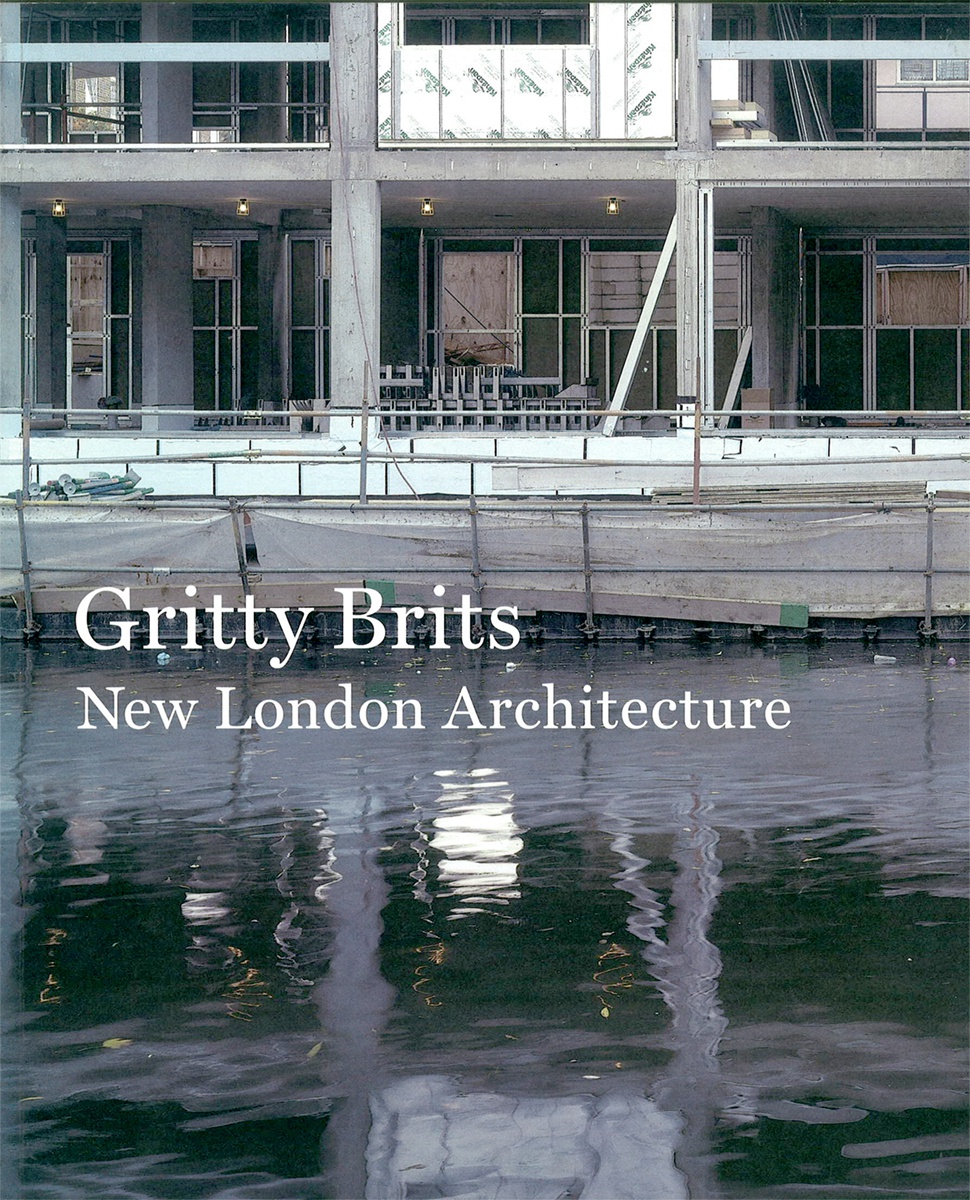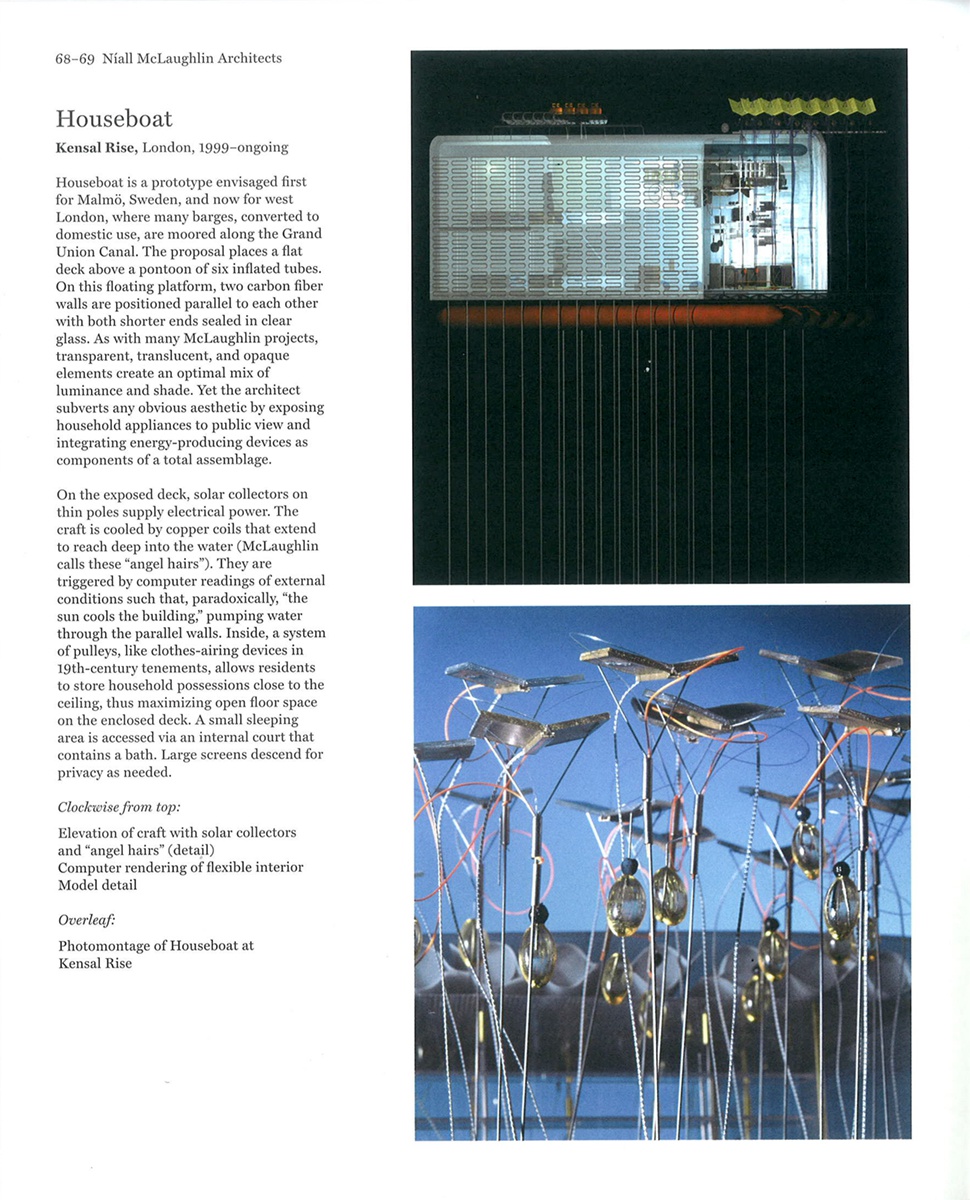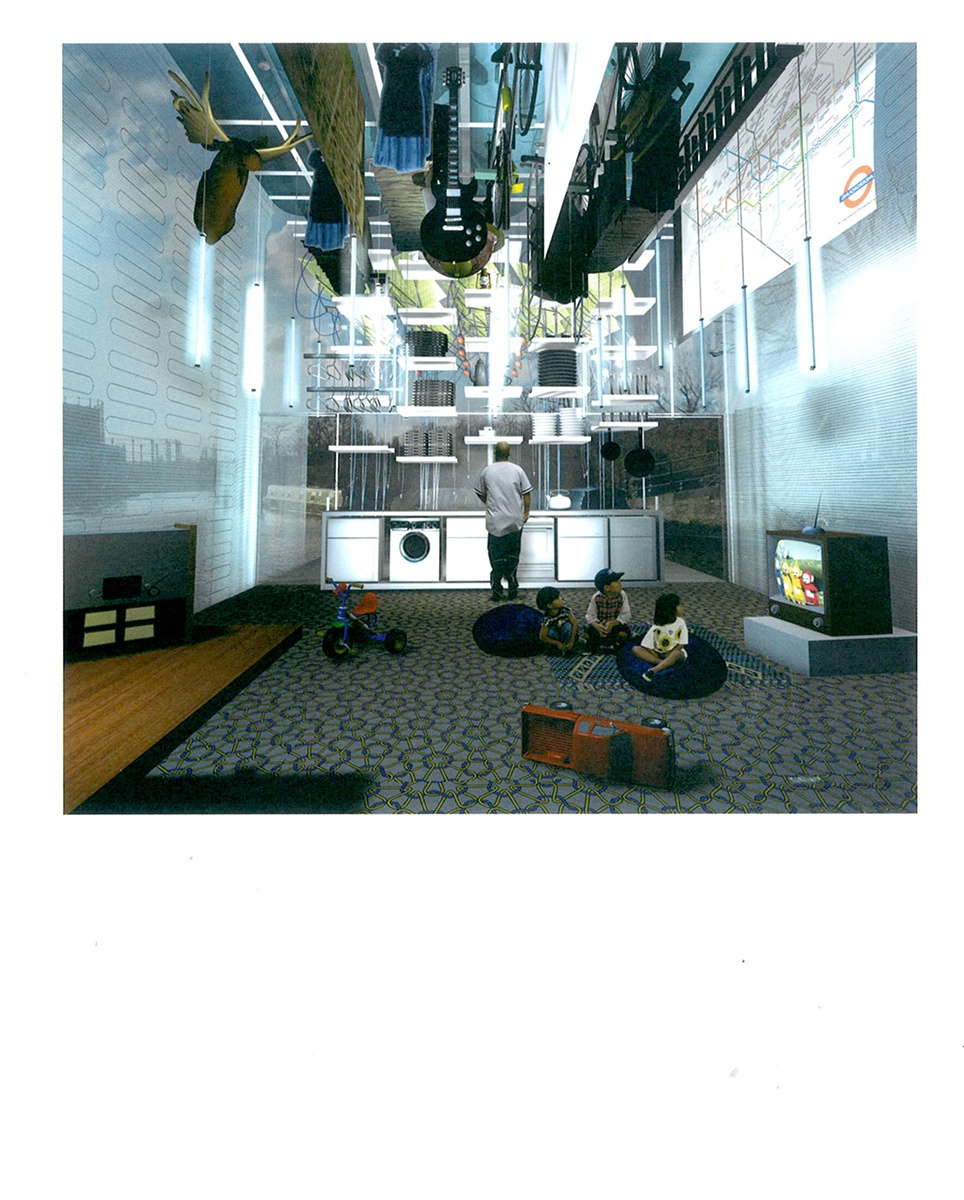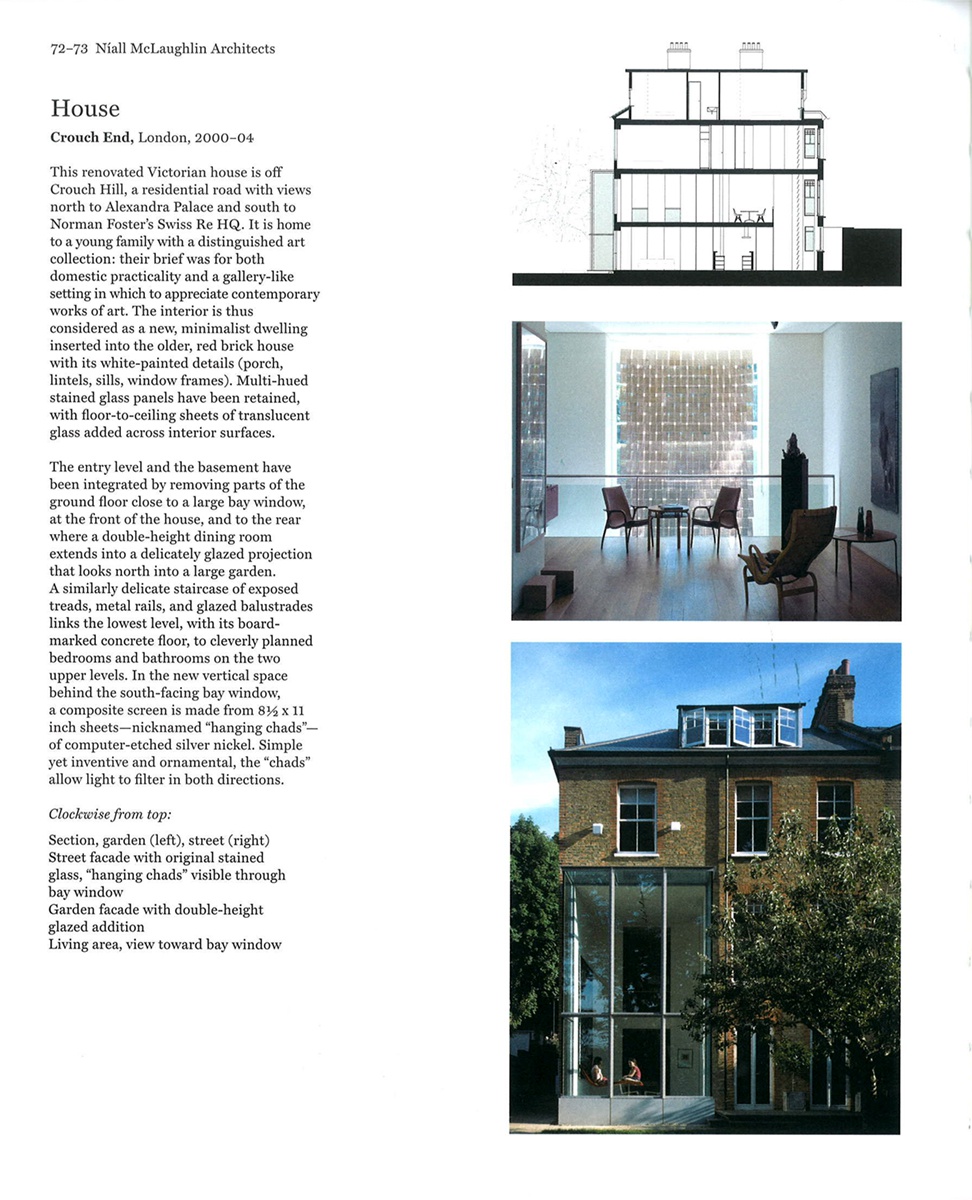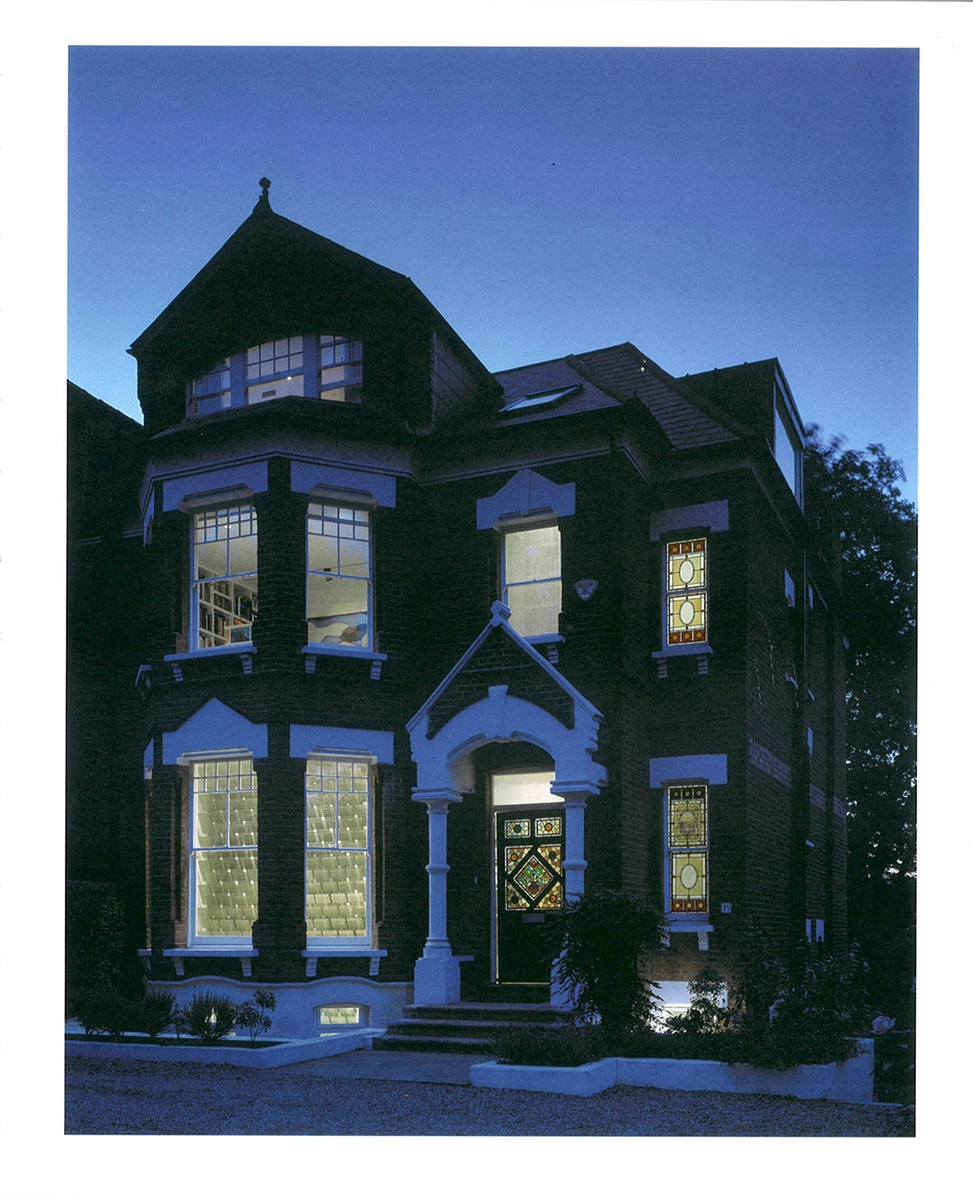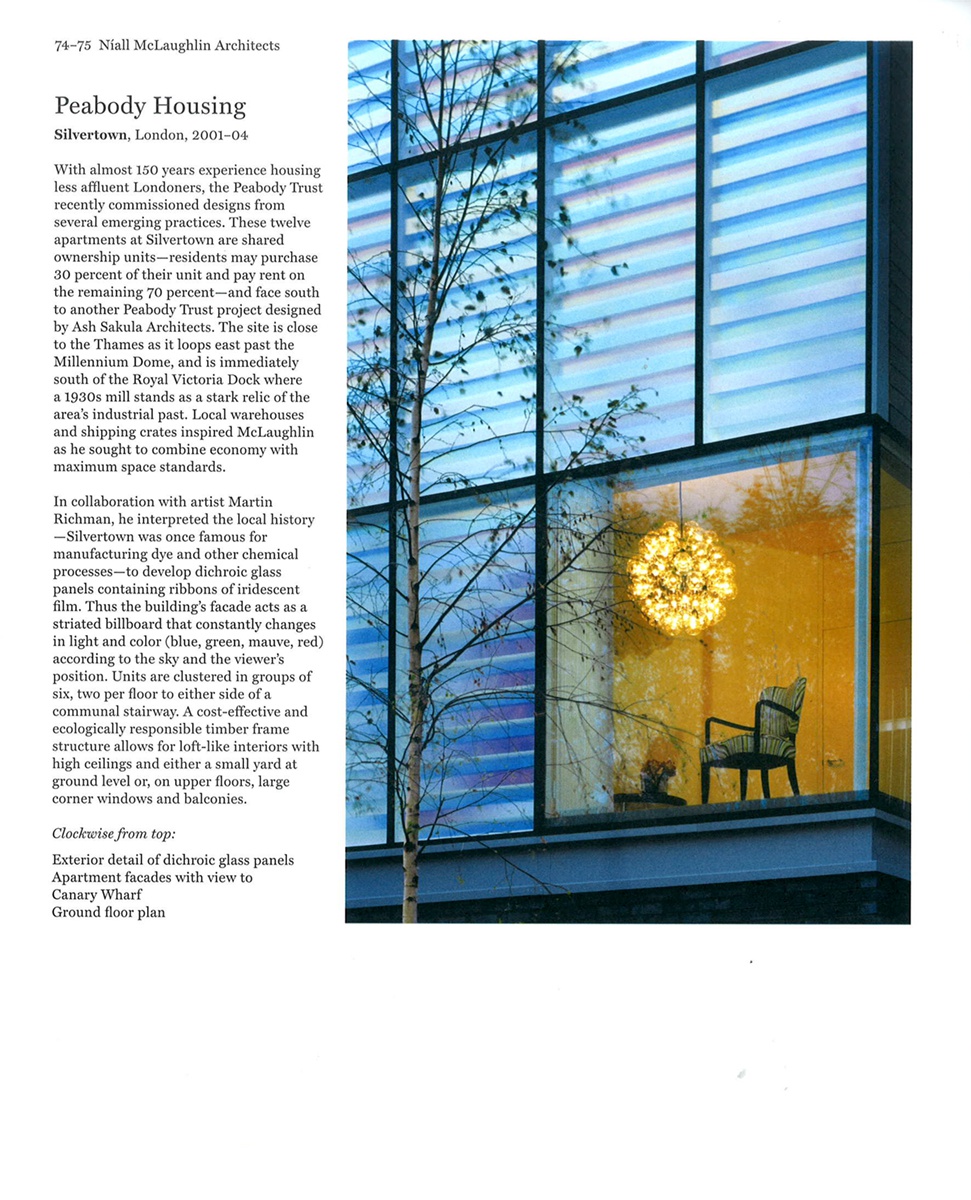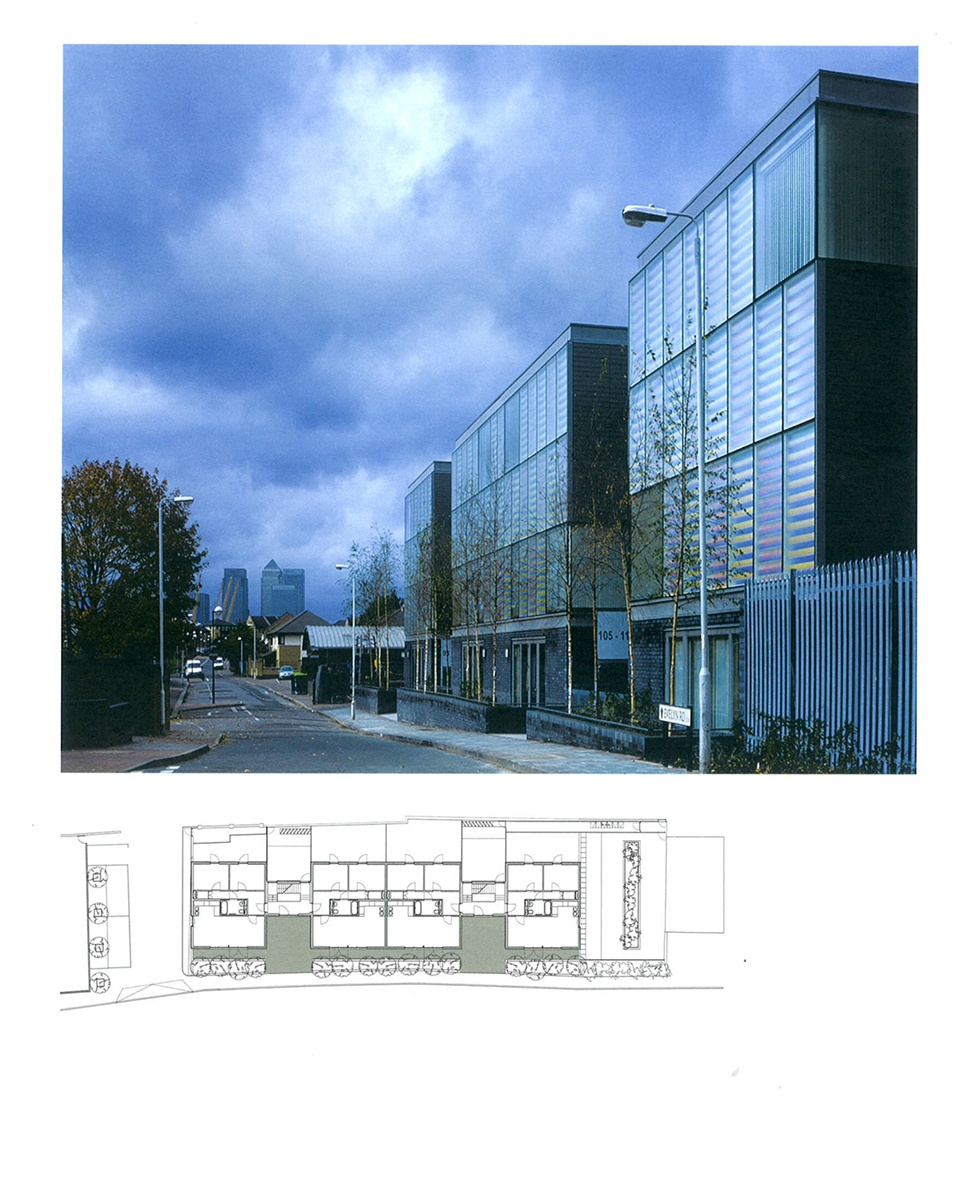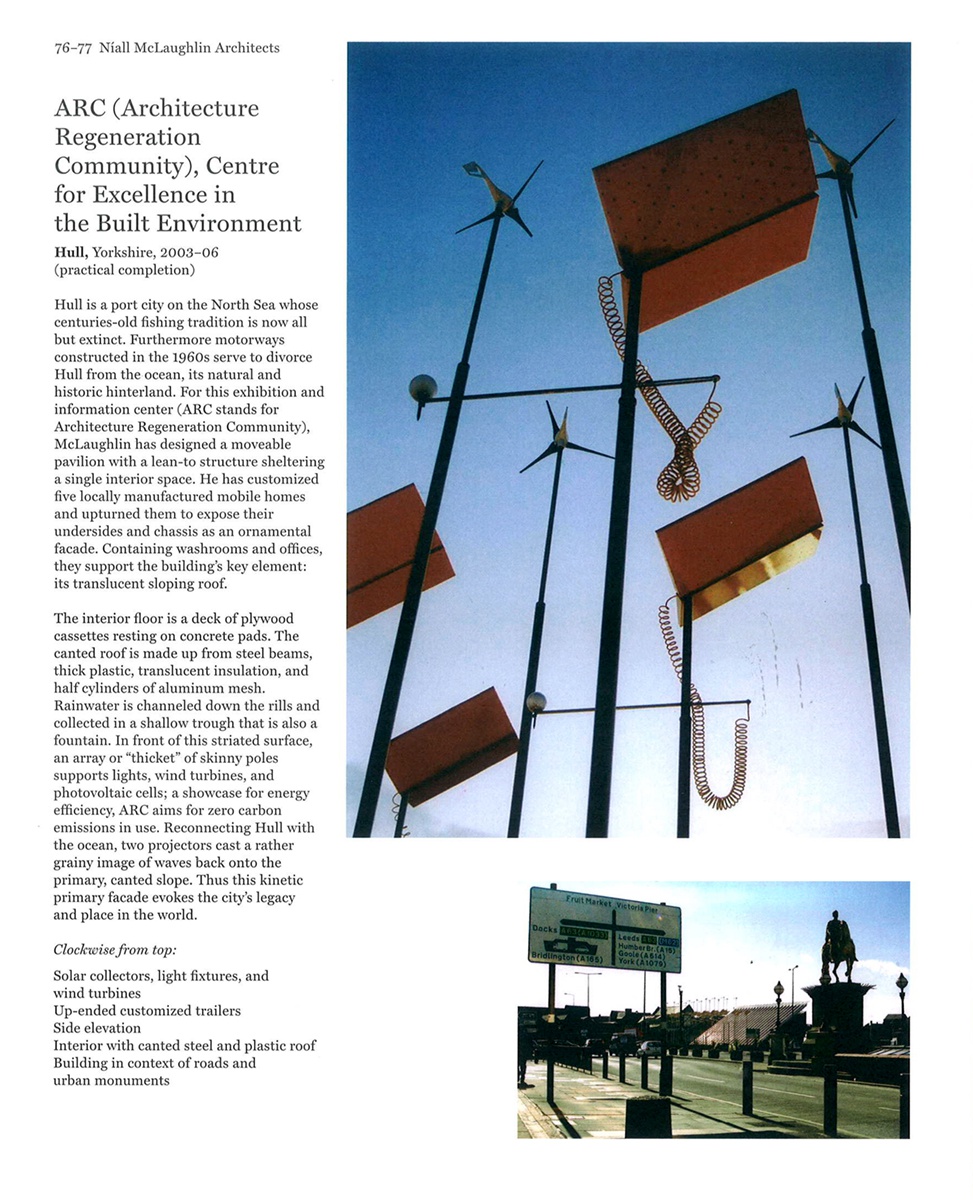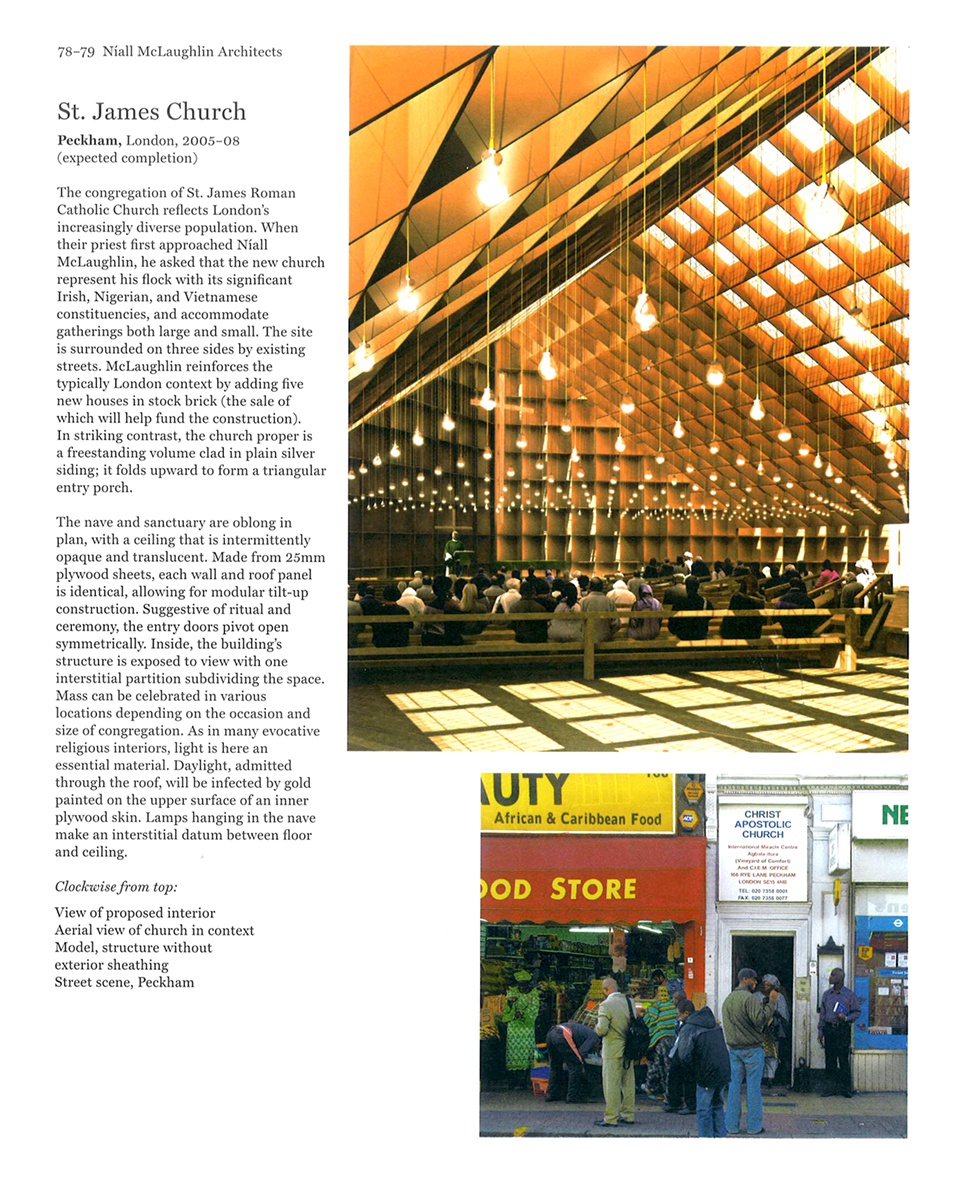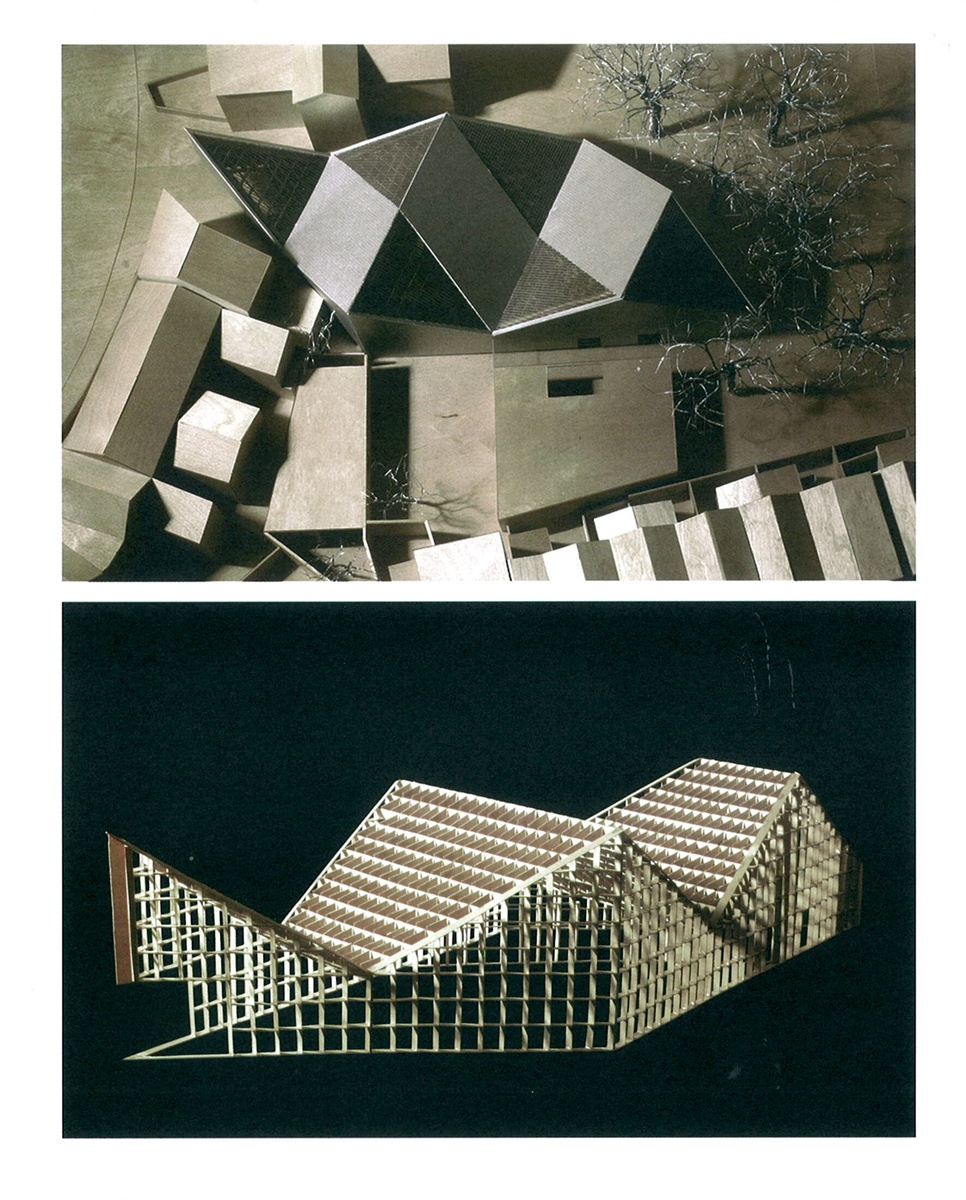Gritty Brits - New London Architecture
Published by Pittsburgh: Carnegie Museum, 2007
Edited by Raymund Ryan
Houseboat
Kensal Rise, London, 1999-ongoing
Houseboat is a prototype envisaged first for Malmö, Sweden, and now for west London, where many barges, converted to domestic use, are moored along the Grand Union Canal. The proposal places a flat deck above a pontoon of six inflated tubes. On this floating platform, two carbon fiber walls are positioned parallel to each other with both shorter ends sealed in clear glass. As with many McLaughlin projects, transparent, translucent, and opaque elements create an optimal mix of luminance and shade. Yet the architect subverts any obvious aesthetic by exposing household appliances to public view and integrating energy-producing devices as components of a total assemblage.
On the exposed deck, solar collectors on thin poles supply electrical power. The craft is cooled by copper coils that extend to reach deep into the water (McLaughlin calls these ‘angel hairs’). They are triggered by computer readings of external conditions such that, paradoxically, ‘the sun cools the building,’ pumping water through the parallel walls. Inside, a system of pulleys, like clothes-airing devices in 19th-century tenements, allows residents to store household possessions close to the ceiling, thus maximizing open floor space on the enclosed deck. A small sleeping area is accessed via an internal court that contains a bath. Large screens descend for privacy as needed.
House
Crouch End, London, 2000-04
This renovated Victorian house is off Crouch Hill, a residential road with views north to Alexandra Palace and south to Norman Foster’s Swiss Re HQ. It is home to a young family with a distinguished art collection: their brief was for both domestic practicality and a gallery-like setting in which to appreciate contemporary works of art. The interior is thus considered as a new, minimalist dwelling inserted into the older, red brick house with its white-painted details (porch, lintels, sills, window frames). Multi-hued stained glass panels have been retained, with floor-to-ceiling sheets of translucent glass added across interior surfaces.
The entry level and the basement have been integrated by removing parts of the ground floor close to a large bay window, at the front of the house, and to the rear where a double-height dining room extends into a delicately glazed projection that looks north into a large garden. A similarly delicate staircase of exposed treads, metal rails, and glazed balustrades links the lowest level, with its board marked concrete floor, to cleverly planned bedrooms and bathrooms on the two upper levels. In the new vertical space behind the south-facing bay window, a composite screen is made from 8 1/2 x 11 inch sheets – nicknamed ‘hanging chads’ of computer-etched silver nickel. Simple yet inventive and ornamental, the ‘chads’ allow light to filter in both directions.
Peabody Housing
Silvertown, London, 2001-04
With almost 150 years experience housing less affluent Londoners, the Peabody Trust recently commissioned designs from several emerging practices. These twelve apartments at Silvertown are shared ownership units – residents may purchase 30 percent of their unit and pay rent on the remaining 70 percent – and face south to another Peabody Trust project designed by Ash Sakula Architects. The site is close to the Thames as it loops east past the Millennium Dome, and is immediately south of the Royal Victoria Dock where a 1930s mill stands as a stark relic of the area’s industrial past. Local warehouses and shipping crates inspired McLaughlin as he sought to combine economy with maximum space standards.
In collaboration with artist Martin Richman, he interpreted the local history – Silvertown was once famous for manufacturing dye and other chemical processes – to develop dichroic glass panels containing ribbons of iridescent film. Thus the building’s facade acts as a striated billboard that constantly changes in light and color (blue, green, mauve, red) according to the sky and the viewer’s position. Units are clustered in groups of six, two per floor to either side of a communal stairway. A cost-effective and ecologically responsible timber frame structure allows for loft-like interiors with high ceilings and either a small yard at ground level or, on upper floors, large corner windows and balconies.
ARC (Architecture Regeneration Community), Centre for Excellence in the Built Environment
Hull, Yorkshire, 2003-06
Hull is a port city on the North Sea whose centuries-old fishing tradition is now all but extinct. Furthermore motorways constructed in the 1960s serve to divorce Hull from the ocean, its natural and historic hinterland. For this exhibition and information center (ARC stands for Architecture Regeneration Community), McLaughlin has designed a moveable pavilion with a lean-to structure sheltering a single interior space. He has customized five locally manufactured mobile homes and upturned them to expose their undersides and chassis as an ornamental facade. Containing washrooms and offices, they support the building’s key element: its translucent sloping roof.
The interior floor is a deck of plywood cassettes resting on concrete pads. The canted roof is made up from steel beams, thick plastic, translucent insulation, and half cylinders of aluminum mesh. Rainwater is channeled down the rills and collected in a shallow trough that is also a fountain. In front of this striated surface, an array or ‘thicket’ of skinny poles supports lights, wind turbines, and photovoltaic cells; a showcase for energy efficiency, ARC aims for zero carbon emissions in use. Reconnecting Hull with the ocean, two projectors cast a rather grainy image of waves back onto the primary, canted slope. Thus this kinetic primary facade evokes the city’s legacy and place in the world.
St. James Church
Peckham, London, 2005-08 (expected completion)
The congregation of St. James Roman Catholic Church reflects London’s increasingly diverse population. When their priest first approached Niall McLaughlin, he asked that the new church represent his flock with its significant Irish, Nigerian, and Vietnamese constituencies, and accommodate gatherings both large and small. The site is surrounded on three sides by existing streets. McLaughlin reinforces the typically London context by adding five new houses in stock brick (the sale of which will help fund the construction). In striking contrast, the church proper is a freestanding volume clad in plain silver siding; it folds upward to form a triangular entry porch.
The nave and sanctuary are oblong in plan, with a ceiling that is intermittently opaque and translucent. Made from 25mm plywood sheets, each wall and roof panel is identical, allowing for modular tilt-up construction. Suggestive of ritual and ceremony, the entry doors pivot open symmetrically. Inside, the building’s structure is exposed to view with one interstitial partition subdividing the space. Mass can be celebrated in various locations depending on the occasion and size of congregation. As in many evocative religious interiors, light is here an essential material. Daylight, admitted through the roof, will be infected by gold painted on the upper surface of an inner plywood skin. Lamps hanging in the nave make an interstitial datum between floor and ceiling.
